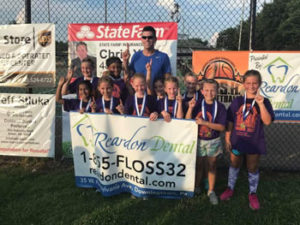Babies usually start cutting their first teeth between 6 and 12 months of age. Loss of the primary dentition begins at age 6 or 7 and is followed by the eruption of the permanent, secondary molars. Oral decay and illness are possible in youngsters without regular dental care, and these may create a lot of trouble for them later in life. Infectious tooth decay in young children is more prevalent than asthma or hay fever by a factor of five and seven, respectively. Approximately one in five youngsters (or 20%) between the ages of 5 and 11 has untreated dental decay. All these point to the fact that a visit to a pediatric dentist is an important aspect of child health care.
Who is a Pediatric Dentist?
A pediatric dentist is a dental professional who, after earning their bachelor’s degree, must complete two to three years of additional specialty education before being licensed to practice dentistry on children.Pediatric dentists are trained to manage the unique needs of children’s oral health, including diagnosing and treating dental issues such as cavities, gum disease, and jaw problems. They also provide preventive care such as regular cleanings and fluoride treatments.
From infancy on up to the teenage years, pediatric dentists focus on the developmentally appropriate care of their patients’ teeth. They are trained and equipped to treat children at any of the many ages when dental and oral health needs change.
What types of treatments do pediatric dentists provide?
The pediatric dentist should be your first choice when it comes to choosing a provider for your child’s oral health care needs. You can count on one for:
Preventive treatments
A pediatric dentist will provide preventive care such as regular cleanings, fluoride treatment, sealants, and dietary counseling to ensure that your child has good oral health habits for life.
Restorative dentistry
If a cavity or other problem is found, a pediatric dentist can fix it with procedures like composite fillings, which are tooth-colored instead of metal. They also use crowns and root canal therapy to restore teeth to health so they look and function properly again.
Orthodontics
Pediatric dentists can identify problems with the alignment of your child’s teeth and jaws. If necessary, they can provide braces or other orthodontic treatments to help straighten the teeth and promote a healthy bite.
Emergency care
Pediatric dentists are also trained to handle any dental emergency that may arise, such as a knocked-out tooth or sudden, severe pain. They are experienced in providing quick relief for your child when dental issues come up unexpectedly.


What a Pediatric Dentist Does
Here are some of the services a pediatric dentist offers your child or teen:
Oral health exams for early detection of oral health conditions
A pediatric dentist makes sure that the child is healthy and that there are no possible dental issues. This helps in the early detection of any problems, which can be easily treated in the early stages.
Teeth cleaning and fluoride treatments
A pediatric dentist also helps in cleaning and protecting the teeth from cavities. Fluoride treatments are necessary to prevent tooth decay and keep a child’s teeth healthy.
Preventive measures
The dentist can also suggest preventive measures in order to lower the chances of any dental issues. This may include regular brushing and flossing, the use of fluoride-containing toothpaste and mouthwash, as well as avoiding certain foods that are high in sugar.
Teeth straightening
Braces and other orthodontic treatments can be used to help straighten the teeth of children. This helps in improving the appearance of their smile and is also important for proper chewing and speaking.
Cavity removal
In some cases, children may need to have cavities filled or teeth extracted. These treatments are usually done under local anesthetic and help to eliminate any pain and discomfort caused by the cavities.
Repair for dental injuries
A traumatic dental injury may cause a fracture, displacement, or death of the tooth. In these cases, the dentist can repair the damage using composite fillings.
Why Should Your Child See A Pediatric Dentist?
Here are some of the reasons why a visit to a pediatric dentist is essential for your child’s oral health:
- You can make inquiries about your child’s oral health issues and learn more about how to give your child the best oral experience.
- You can also schedule routine dental checkups for your children and teens. This is to help manage and monitor their oral health properly.
- A pediatric dentist is in the best position to answer all your questions and soothe your fears, like the risk of your child developing cavities, and also to offer the best solution to combat this problem if it occurs or how to prevent it.
- The pediatric dentist is also the best person to handle unhealthy habits in children when it comes to their oral health, such as thumb sucking. They will suggest ways to discourage the child from such habits.
- Also, you can always obtain preventive treatments like fluorides and sealants from a pediatric dentist, especially if you are looking for one that is best suited for your child.
What to Expect When Visiting a Pediatric Dentist
A pediatric dentist specializes in treating children, so his or her clinic is designed with youngsters in mind. Their atmosphere is more friendly and welcoming than that of a typical adult dental office. All of the furnishings are scaled down to fit a child’s body, and there are plenty of engaging activities like games and books to keep them occupied.
Pediatric dentists are skilled at communicating with young patients in a language they can grasp. Behavioral strategies like tell-show-do and positive reinforcement are also within their wheelhouse of expertise. Thus, anxiety is reduced, and children may get the medical attention they need. When you have a positive experience at the dentist, it might pave the way to excellent dental health throughout your life. The situation is simplified for the parents as well. Their expertise in calming nervous or scared children during doctor’s visits can help you as a parent relax as well. You can also have all of your concerns addressed and questions answered.
How to find the right pediatric dentist
Finding the right pediatric dentist is not as difficult as it seems; it is actually quite easy, as long as you do the following:
Schedule a time to visit the office and meet the staff and doctors.
Before you choose a pediatric dentist for your child, it’s important to take the time to visit the office and meet the staff. You want to make sure that the staff is experienced and attentive to your child’s needs.
Check qualifications:
When choosing a pediatric dentist, it’s important to make sure that whoever you are working with is qualified and has the necessary experience to provide your child with quality care. Ask about their qualifications, any certifications they have, and their experience in pediatric dentistry.
Research patient reviews:
Reviews can tell you a lot about the quality of care a pediatric dentist provides. Examine what other patients have to say about their dental experiences and whether any complaints or positive reviews stand out.
Ask for recommendations:
Friends and family members can be a great source of information when it comes to finding the best pediatric dentist. Ask around for recommendations, and you may find a great dentist that is perfect for your child.
Answers To Some Other Related Questions
At what age should a child begin seeing a pediatric dentist?
A child should begin visiting a pediatric dentist when they get their first tooth, or no later than age 1. Early visits with the pediatric dentist set the foundation for a lifetime of good oral health.
Why choose a pediatric dentist instead of a general dentist?
Pediatric dentists are specially trained to meet the needs of infants, children, and adolescents. They have more extensive knowledge than general dentists on how to make a child’s dental visit a positive experience. Pediatric dentists are also experienced in dealing with unique needs, such as those of children with special needs.
How do pediatric dentists fill cavities?
When a cavity is found in a child’s tooth, the pediatric dentist will use one of two techniques to fill it. The first is called a “silver” filling, which is made of a combination of mercury and silver. The other type is called a “white” filling, which is made of a composite material that resembles the natural color of teeth.
Do they put toddlers to sleep for fillings?
In some cases, a pediatric dentist may recommend using sedation for fillings in very young children. This can be done with either general anesthesia or with a mild sedative to help the child relax during the procedure. The decision to use sedation for young children is made on an individual basis depending on the child’s age, medical history, and level of anxiety. Parents should discuss their options with the dentist prior to proceeding with any type of sedation.
Contact Us

